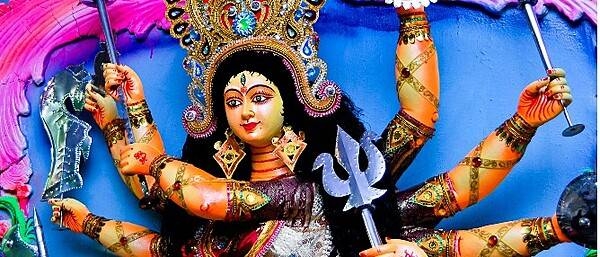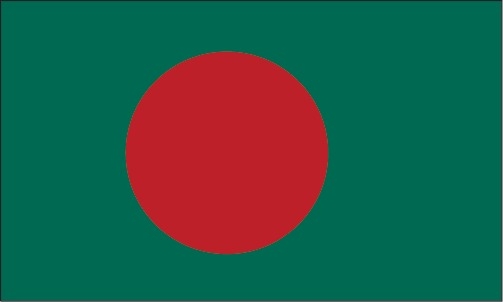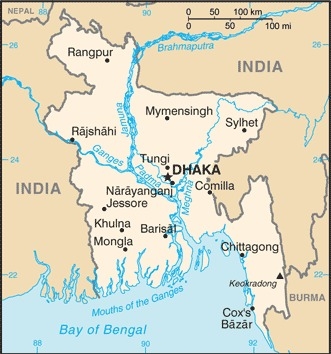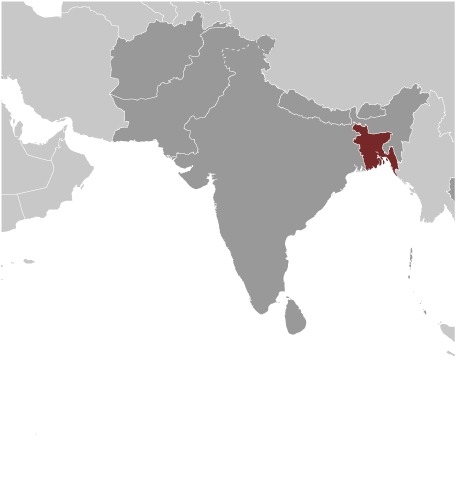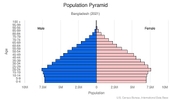Bangladesh
Introduction
Background
The huge delta region formed at the confluence of the Ganges and Brahmaputra River systems - now referred to as Bangladesh - was a loosely incorporated outpost of various empires centered on the Gangetic plain for much of the first millennium A.D. Muslim conversions and settlement in the region began in the 10th century, primarily from Arab and Persian traders and preachers. Europeans established trading posts in the area in the 16th century. Eventually the area known as Bengal, primarily Hindu in the western section and mostly Muslim in the eastern half, became part of British India. Partition in 1947 resulted in an eastern wing of Pakistan in the Muslim-majority area, which became East Pakistan. Calls for greater autonomy and animosity between the eastern and western wings of Pakistan led to a Bengali independence movement. That movement, led by the Awami League (AL) and supported by India, won the independence war for Bangladesh in 1971.
The post-independence AL government faced daunting challenges and in 1975 it was overthrown by the military, triggering a series of military coups that resulted in a military-backed government and subsequent creation of the Bangladesh Nationalist Party (BNP) in 1978. That government also ended in a coup in 1981, followed by military-backed rule until democratic elections occurred in 1991. The BNP and AL have alternated in power since 1991, with the exception of a military-backed, emergency caretaker regime that suspended parliamentary elections planned for January 2007 in an effort to reform the political system and root out corruption. That government returned the country to fully democratic rule in December 2008 with the election of the AL and Prime Minister Sheikh HASINA. In January 2014, the incumbent AL won the national election by an overwhelming majority after the BNP boycotted the election, which extended HASINA's term as prime minister. In December 2018, HASINA secured a third consecutive term (fourth overall) with the AL coalition securing 96% of available seats, amid widespread claims of election irregularities. With the help of international development assistance, Bangladesh has reduced the poverty rate from over half of the population to less than a third, achieved Millennium Development Goals for maternal and child health, and made great progress in food security since independence. The economy has grown at an annual average of about 6% for the last two decades and the country reached World Bank lower-middle income status in 2014.
Visit the Definitions and Notes page to view a description of each topic.
Geography
Location
Southern Asia, bordering the Bay of Bengal, between Burma and India
Geographic coordinates
24 00 N, 90 00 E
Map references
Asia
Area - comparative
slightly larger than Pennsylvania and New Jersey combined; slightly smaller than Iowa
Land boundaries
total: 4,413 km
border countries (2): Burma 271 km, India 4142 km
Coastline
580 km
Maritime claims
territorial sea: 12 nm
contiguous zone: 18 nm
exclusive economic zone: 200 nm
continental shelf: to the outer limits of the continental margin
Climate
tropical; mild winter (October to March); hot, humid summer (March to June); humid, warm rainy monsoon (June to October)
Terrain
mostly flat alluvial plain; hilly in southeast
Elevation
highest point: Keokradong 1,230 m
lowest point: Indian Ocean 0 m
mean elevation: 85 m
Natural resources
natural gas, arable land, timber, coal
Land use
agricultural land: 70.1% (2018 est.)
arable land: 59% (2018 est.)
permanent crops: 6.5% (2018 est.)
permanent pasture: 4.6% (2018 est.)
forest: 11.1% (2018 est.)
other: 18.8% (2018 est.)
Irrigated land
53,000 sq km (2012)
Major watersheds (area sq km)
Indian Ocean drainage: Brahmaputra (651,335 sq km), Ganges (1,016,124 sq km)
Major aquifers
Indus-Ganges-Brahmaputra Basin
Major rivers (by length in km)
Brahmaputra river mouth (shared with China [s] and India) - 3,969 km; Ganges river mouth (shared with India [s]) - 2,704 km
note – [s] after country name indicates river source; [m] after country name indicates river mouth
Natural hazards
droughts; cyclones; much of the country routinely inundated during the summer monsoon season
Geography - note
most of the country is situated on deltas of large rivers flowing from the Himalayas: the Ganges unites with the Jamuna (main channel of the Brahmaputra) and later joins the Meghna to eventually empty into the Bay of Bengal
People and Society
Nationality
noun: Bangladeshi(s)
adjective: Bangladeshi
Ethnic groups
Bengali at least 98%, other indigenous ethnic groups 1.1% (2011 est.)
note: Bangladesh's government recognizes 27 indigenous ethnic groups under the 2010 Cultural Institution for Small Anthropological Groups Act; other sources estimate there are about 75 ethnic groups; critics of the 2011 census claim that it underestimates the size of Bangladesh's ethnic population
Languages
Bangla 98.8% (official, also known as Bengali), other 1.2% (2011 est.)
major-language sample(s):
বিশ্ব ফেসবুক, মৌলিক তথ্যের অপরিহার্য উৎস (Bangla)
The World Factbook, the indispensable source for basic information.
Religions
Muslim 88.4%, other 11.6% (2018 est.)
Age structure
0-14 years: 26.48% (male 21,918,651/female 21,158,574)
15-24 years: 18.56% (male 15,186,470/female 15,001,950)
25-54 years: 40.72% (male 31,694,267/female 34,535,643)
55-64 years: 7.41% (male 5,941,825/female 6,115,856)
65 years and over: 6.82% (male 5,218,206/female 5,879,411) (2020 est.)
Dependency ratios
total dependency ratio: 47
youth dependency ratio: 39.3
elderly dependency ratio: 7.7
potential support ratio: 13 (2020 est.)
Median age
total: 27.9 years
male: 27.1 years
female: 28.6 years (2020 est.)
Urbanization
urban population: 38.9% of total population (2021)
rate of urbanization: 2.88% annual rate of change (2020-25 est.)
Major urban areas - population
21.741 million DHAKA (capital), 5.133 million Chittagong, 949,000 Khulna, 924,000 Rajshahi, 890,000 Sylhet, Bogra 820,000 (2021)
Sex ratio
at birth: 1.04 male(s)/female
0-14 years: 1.04 male(s)/female
15-24 years: 1.01 male(s)/female
25-54 years: 0.92 male(s)/female
55-64 years: 0.97 male(s)/female
65 years and over: 0.89 male(s)/female
total population: 0.97 male(s)/female (2020 est.)
Mother's mean age at first birth
18.6 years (2017/18 est.)
note: median age at first birth among women 20-49
Maternal mortality ratio
173 deaths/100,000 live births (2017 est.)
country comparison to the world: 53Infant mortality rate
total: 31.13 deaths/1,000 live births
male: 33.82 deaths/1,000 live births
female: 28.34 deaths/1,000 live births (2021 est.)
Life expectancy at birth
total population: 74.43 years
male: 72.25 years
female: 76.7 years (2021 est.)
Contraceptive prevalence rate
62.7% (2019)
Drinking water source
improved: urban: 98.9% of population
rural: 98.4% of population
total: 98.6% of population
unimproved: urban: 1.1% of population
rural: 1.6% of population
total: 1.4% of population (2017 est.)
Current Health Expenditure
2.3% (2018)
Physicians density
0.58 physicians/1,000 population (2018)
Hospital bed density
0.8 beds/1,000 population (2016)
Sanitation facility access
improved: urban: 82.5% of population
rural: 64.4% of population
total: 70.9% of population
unimproved: urban: 17.5% of population
rural: 35.6% of population
total: 29.1% of population (2017 est.)
HIV/AIDS - adult prevalence rate
<.1% (2018 est.)
HIV/AIDS - deaths
<1000 (2018 est.)
Major infectious diseases
degree of risk: high (2020)
food or waterborne diseases: bacterial and protozoal diarrhea, hepatitis A and E, and typhoid fever
vectorborne diseases: dengue fever and malaria are high risks in some locations
water contact diseases: leptospirosis
animal contact diseases: rabies
note: widespread ongoing transmission of a respiratory illness caused by the novel coronavirus (COVID-19) is occurring throughout Bangladesh; as of 6 October 2021, Bangladesh has reported a total of 1,560,155 cases of COVID-19 or 947.33 cumulative cases of COVID-19 per 100,000 population with 16.78 cumulative deaths per 100,000 population; as of 5 October 2021, 10.46% of the population has received at least one dose of COVID-19 vaccine
Literacy
definition: age 15 and over can read and write
total population: 74.9%
male: 77.8%
female: 72% (2020)
School life expectancy (primary to tertiary education)
total: 12 years
male: 12 years
female: 13 years (2020)
Unemployment, youth ages 15-24
total: 12.8%
male: 10.8%
female: 16.8% (2017 est.)
Environment
Environment - current issues
many people are landless and forced to live on and cultivate flood-prone land; waterborne diseases prevalent in surface water; water pollution, especially of fishing areas, results from the use of commercial pesticides; ground water contaminated by naturally occurring arsenic; intermittent water shortages because of falling water tables in the northern and central parts of the country; soil degradation and erosion; deforestation; destruction of wetlands; severe overpopulation with noise pollution
Environment - international agreements
party to: Biodiversity, Climate Change, Climate Change-Kyoto Protocol, Climate Change-Paris Agreement, Comprehensive Nuclear Test Ban, Desertification, Endangered Species, Environmental Modification, Hazardous Wastes, Law of the Sea, Nuclear Test Ban, Ozone Layer Protection, Ship Pollution, Wetlands
signed, but not ratified: none of the selected agreements
Air pollutants
particulate matter emissions: 58.33 micrograms per cubic meter (2016 est.)
carbon dioxide emissions: 84.25 megatons (2016 est.)
methane emissions: 59.3 megatons (2020 est.)
Climate
tropical; mild winter (October to March); hot, humid summer (March to June); humid, warm rainy monsoon (June to October)
Land use
agricultural land: 70.1% (2018 est.)
arable land: 59% (2018 est.)
permanent crops: 6.5% (2018 est.)
permanent pasture: 4.6% (2018 est.)
forest: 11.1% (2018 est.)
other: 18.8% (2018 est.)
Urbanization
urban population: 38.9% of total population (2021)
rate of urbanization: 2.88% annual rate of change (2020-25 est.)
Revenue from forest resources
forest revenues: 0.08% of GDP (2018 est.)
country comparison to the world: 117Major infectious diseases
degree of risk: high (2020)
food or waterborne diseases: bacterial and protozoal diarrhea, hepatitis A and E, and typhoid fever
vectorborne diseases: dengue fever and malaria are high risks in some locations
water contact diseases: leptospirosis
animal contact diseases: rabies
note: widespread ongoing transmission of a respiratory illness caused by the novel coronavirus (COVID-19) is occurring throughout Bangladesh; as of 6 October 2021, Bangladesh has reported a total of 1,560,155 cases of COVID-19 or 947.33 cumulative cases of COVID-19 per 100,000 population with 16.78 cumulative deaths per 100,000 population; as of 5 October 2021, 10.46% of the population has received at least one dose of COVID-19 vaccine
Food insecurity
severe localized food insecurity: due to economic constraints - food insecurity poverty levels have increased due to income losses and a decline in remittances caused by the effects of the COVID‑19 pandemic (2021)
Waste and recycling
municipal solid waste generated annually: 14,778,497 tons (2012 est.)
Major rivers (by length in km)
Brahmaputra river mouth (shared with China [s] and India) - 3,969 km; Ganges river mouth (shared with India [s]) - 2,704 km
note – [s] after country name indicates river source; [m] after country name indicates river mouth
Major watersheds (area sq km)
Indian Ocean drainage: Brahmaputra (651,335 sq km), Ganges (1,016,124 sq km)
Major aquifers
Indus-Ganges-Brahmaputra Basin
Total water withdrawal
municipal: 3.6 billion cubic meters (2017 est.)
industrial: 770 million cubic meters (2017 est.)
agricultural: 31.5 billion cubic meters (2017 est.)
Total renewable water resources
1,227,032,000,000 cubic meters (2017 est.)
Government
Country name
conventional long form: People's Republic of Bangladesh
conventional short form: Bangladesh
local long form: Gana Prajatantri Bangladesh
local short form: Bangladesh
former: East Bengal, East Pakistan
etymology: the name - a compound of the Bengali words "Bangla" (Bengal) and "desh" (country) - means "Country of Bengal"
Government type
parliamentary republic
Capital
name: Dhaka
geographic coordinates: 23 43 N, 90 24 E
time difference: UTC+6 (11 hours ahead of Washington, DC, during Standard Time)
etymology: the origins of the name are unclear, but some sources state that the city's site was originally called "dhakka," meaning "watchtower," and that the area served as a watch-station for Bengal rulers
Administrative divisions
8 divisions; Barishal, Chattogram, Dhaka, Khulna, Mymensingh, Rajshahi, Rangpur, Sylhet
Independence
16 December 1971 (from Pakistan)
National holiday
Independence Day, 26 March (1971); Victory Day, 16 December (1971); note - 26 March 1971 is the date of the Awami League's declaration of an independent Bangladesh, and 16 December (Victory Day) memorializes the military victory over Pakistan and the official creation of the state of Bangladesh
Constitution
history: previous 1935, 1956, 1962 (preindependence); latest enacted 4 November 1972, effective 16 December 1972, suspended March 1982, restored November 1986
amendments: proposed by the House of the Nation; approval requires at least two-thirds majority vote of the House membership and assent of the president of the republic; amended many times, last in 2018
Legal system
mixed legal system of mostly English common law and Islamic law
International law organization participation
has not submitted an ICJ jurisdiction declaration; accepts ICCt jurisdiction
Citizenship
citizenship by birth: no
citizenship by descent only: at least one parent must be a citizen of Bangladesh
dual citizenship recognized: yes, but limited to select countries
residency requirement for naturalization: 5 years
Suffrage
18 years of age; universal
Executive branch
chief of state: President Abdul HAMID (since 24 April 2013); note - Abdul HAMID served as acting president following the death of Zillur RAHMAN in March 2013; HAMID was subsequently indirectly elected by the National Parliament and sworn in 24 April 2013
head of government: Prime Minister Sheikh HASINA Wazed (since 6 January 2009)
cabinet: Cabinet selected by the prime minister, appointed by the president
elections/appointments: president indirectly elected by the National Parliament for a 5-year term (eligible for a second term); election last held on 7 February 2018 (next to be held by 2023); the president appoints as prime minister the majority party leader in the National Parliament
election results: President Abdul HAMID (AL) reelected by the National Parliament unopposed for a second term; Sheikh HASINA reappointed prime minister as leader of the majority AL party following parliamentary elections in 2018
Legislative branch
description: unicameral House of the Nation or Jatiya Sangsad (350 seats; 300 members in single-seat territorial constituencies directly elected by simple majority vote; 50 members - reserved for women only - indirectly elected by the elected members by proportional representation vote using single transferable vote; all members serve 5-year terms)
elections: last held on 30 December 2018 (next to be held in December 2023)
election results: percent of vote by party - NA; seats by party as of January 2020 - AL 299, JP 27, BNP 7, other 10, independent 4; composition - men 277, women 73, percent of women 20.9%
Judicial branch
highest courts: Supreme Court of Bangladesh (organized into the Appellate Division with 7 justices and the High Court Division with 99 justices)
judge selection and term of office: chief justice and justices appointed by the president; justices serve until retirement at age 67
subordinate courts: civil courts include: Assistant Judge's Court; Joint District Judge's Court; Additional District Judge's Court; District Judge's Court; criminal courts include: Court of Sessions; Court of Metropolitan Sessions; Metropolitan Magistrate Courts; Magistrate Court; special courts/tribunals
Political parties and leaders
Awami League or AL [Sheikh HASINA]
Bangladesh Nationalist Front or BNF [Abdul Kalam AZADI]
Bangladesh Nationalist Party or BNP [Khaleda ZIA]
Bangladesh Tariqat Federation or BTF [Syed Nozibul Bashar MAIZBHANDARI]
Jamaat-i-Islami Bangladesh or JIB (Makbul AHMAD)
Jatiya Party or JP (Ershad faction) [Hussain Mohammad ERSHAD]
Jatiya Party or JP (Manju faction) [Anwar Hossain MANJU]
Liberal Democratic Party or LDP [Oli AHMED]
National Socialist Party or JSD [KHALEQUZZAMAN]
Workers Party or WP [Rashed Khan MENON]
International organization participation
ADB, ARF, BIMSTEC, C, CD, CICA (observer), CP, D-8, FAO, G-77, IAEA, IBRD, ICAO, ICC (national committees), ICRM, IDA, IDB, IFAD, IFC, IFRCS, IHO, ILO, IMF, IMO, IMSO, Interpol, IOC, IOM, IPU, ISO, ITSO, ITU, ITUC (NGOs), MIGA, MINURSO, MINUSMA, MONUSCO, NAM, OIC, OPCW, PCA, SAARC, SACEP, UN, UNAMID, UNCTAD, UNESCO, UNHCR, UNIDO, UNIFIL, UNMIL, UNMISS, UNOCI, UNWTO, UPU, WCO, WFTU (NGOs), WHO, WIPO, WMO, WTO
Diplomatic representation in the US
chief of mission: Ambassador M Shahidul ISLAM (since 17 February 2021)
chancery: 3510 International Drive NW, Washington, DC 20008
telephone: [1] (202) 244-0183
FAX: [1] (202) 244-2771; [1] (202) 244 7830
email address and website:
mission.washington@mofa.gov.bd
http://www.bdembassyusa.org/
consulate(s) general: Los Angeles, New York
Diplomatic representation from the US
chief of mission: Ambassador Earl Robert MILLER (since 29 November 2018)
embassy: Madani Avenue, Baridhara, Dhaka - 1212
mailing address: 6120 Dhaka Place, Washington DC 20521-6120
telephone: [880] (2) 5566-2000
FAX: [880] (2) 5566-2907
email address and website:
DhakaACS@state.gov
https://bd.usembassy.gov/
Flag description
green field with a large red disk shifted slightly to the hoist side of center; the red disk represents the rising sun and the sacrifice to achieve independence; the green field symbolizes the lush vegetation of Bangladesh
National symbol(s)
Bengal tiger, water lily; national colors: green, red
National anthem
name: "Amar Shonar Bangla" (My Golden Bengal)
lyrics/music: Rabindranath TAGORE
note: adopted 1971; Rabindranath TAGORE, a Nobel laureate, also wrote India's national anthem
Economy
Economic overview
Bangladesh's economy has grown roughly 6% per year since 2005 despite prolonged periods of political instability, poor infrastructure, endemic corruption, insufficient power supplies, and slow implementation of economic reforms. Although more than half of GDP is generated through the services sector, almost half of Bangladeshis are employed in the agriculture sector, with rice as the single-most-important product.
Garments, the backbone of Bangladesh's industrial sector, accounted for more than 80% of total exports in FY 2016-17. The industrial sector continues to grow, despite the need for improvements in factory safety conditions. Steady export growth in the garment sector, combined with $13 billion in remittances from overseas Bangladeshis, contributed to Bangladesh's rising foreign exchange reserves in FY 2016-17. Recent improvements to energy infrastructure, including the start of liquefied natural gas imports in 2018, represent a major step forward in resolving a key growth bottleneck.
Real GDP (purchasing power parity)
$793.49 billion note: data are in 2017 dollars (2020 est.)
$775.08 billion note: data are in 2017 dollars (2019 est.)
$716.65 billion note: data are in 2017 dollars (2018 est.)
note: data are in 2010 dollars
Real GDP growth rate
7.4% (2017 est.)
7.2% (2016 est.)
6.8% (2015 est.)
Real GDP per capita
$4,800 note: data are in 2017 dollars (2020 est.)
$4,800 note: data are in 2017 dollars (2019 est.)
$4,400 note: data are in 2017 dollars (2018 est.)
note: data are in 2010 dollars
GDP (official exchange rate)
$329.545 billion (2020 est.)
Inflation rate (consumer prices)
5.5% (2019 est.)
5.5% (2018 est.)
5.6% (2017 est.)
Credit ratings
Fitch rating: BB- (2014)
Moody's rating: Ba3 (2012)
Standard & Poors rating: BB- (2010)
GDP - composition, by sector of origin
agriculture: 14.2% (2017 est.)
industry: 29.3% (2017 est.)
services: 56.5% (2017 est.)
GDP - composition, by end use
household consumption: 68.7% (2017 est.)
government consumption: 6% (2017 est.)
investment in fixed capital: 30.5% (2017 est.)
investment in inventories: 1% (2017 est.)
exports of goods and services: 15% (2017 est.)
imports of goods and services: -20.3% (2017 est.)
Agricultural products
rice, potatoes, maize, sugar cane, milk, vegetables, onions, jute, mangoes/guavas, wheat
Industries
jute, cotton, garments, paper, leather, fertilizer, iron and steel, cement, petroleum products, tobacco, pharmaceuticals, ceramics, tea, salt, sugar, edible oils, soap and detergent, fabricated metal products, electricity, natural gas
Labor force
66.64 million (2017 est.)
note: extensive migration of labor to Saudi Arabia, Kuwait, UAE, Oman, Qatar, and Malaysia
Labor force - by occupation
agriculture: 42.7%
industry: 20.5%
services: 36.9% (2016 est.)
Unemployment rate
4.4% (2017 est.)
4.4% (2016 est.)
note: about 40% of the population is underemployed; many persons counted as employed work only a few hours a week and at low wages
Population below poverty line
24.3% (2016 est.)
Gini Index coefficient - distribution of family income
32.4 (2016 est.)
33.2 (2005)
Household income or consumption by percentage share
lowest 10%: 4%
highest 10%: 27% (2010 est.)
Budget
revenues: 25.1 billion (2017 est.)
expenditures: 33.5 billion (2017 est.)
Fiscal year
1 July - 30 June
Current account balance
-$5.322 billion (2017 est.)
$1.391 billion (2016 est.)
Exports
$38.78 billion note: data are in current year dollars (2020 est.)
$44.96 billion note: data are in current year dollars (2019 est.)
$44.13 billion note: data are in current year dollars (2018 est.)
Exports - partners
United States 15%, Germany 14%, United Kingdom 8%, Spain 7%, France 7% (2019)
Exports - commodities
clothing, knitwear, leather footwear (2019)
Imports
$57.26 billion note: data are in current year dollars (2020 est.)
$64.23 billion note: data are in current year dollars (2019 est.)
$65.59 billion note: data are in current year dollars (2018 est.)
Imports - partners
China 31%, India 15%, Singapore 5% (2019)
Imports - commodities
refined petroleum, cotton, natural gas, scrap iron, wheat (2019)
Reserves of foreign exchange and gold
$33.42 billion (31 December 2017 est.)
$32.28 billion (31 December 2016 est.)
Debt - external
$50.26 billion (31 December 2017 est.)
$41.85 billion (31 December 2016 est.)
Exchange rates
taka (BDT) per US dollar -
84.75 (2020 est.)
85 (2019 est.)
83.715 (2018 est.)
77.947 (2014 est.)
77.614 (2013 est.)
Unemployment, youth ages 15-24
total: 12.8%
male: 10.8%
female: 16.8% (2017 est.)
Energy
Electricity access
electrification - total population: 83% (2019)
electrification - urban areas: 93% (2019)
electrification - rural areas: 77% (2019)
Electricity - installed generating capacity
11.9 million kW (2016 est.)
country comparison to the world: 56Electricity - from fossil fuels
97% of total installed capacity (2016 est.)
country comparison to the world: 32Electricity - from nuclear fuels
0% of total installed capacity (2017 est.)
country comparison to the world: 45Electricity - from hydroelectric plants
2% of total installed capacity (2017 est.)
country comparison to the world: 136Electricity - from other renewable sources
2% of total installed capacity (2017 est.)
country comparison to the world: 133Refined petroleum products - production
26,280 bbl/day (2015 est.)
country comparison to the world: 86Refined petroleum products - consumption
106,000 bbl/day (2016 est.)
country comparison to the world: 77Natural gas - proved reserves
185.8 billion cu m (1 January 2018 est.)
country comparison to the world: 44Communications
Telephones - fixed lines
total subscriptions: 1,450,321 (2020)
subscriptions per 100 inhabitants: less than 1 (2020 est.)
Telephones - mobile cellular
total subscriptions: 170,136,762 (2020)
subscriptions per 100 inhabitants: 103.3 (2020 est.)
Telecommunication systems
general assessment: Bangladesh’s economic constraints hinder network infrastructure, resulting in the lowest fixed-line penetration rate in South Asia and a very low fixed broadband rate; most consumers utilize mobile broadband for data on LTE networks but rates are still well below that of most other Asian countries; the government approved a modernization project to support investment and prepare for 5G launches; 2020 test of 5G technology in Dhaka; government directive allows IoT for smart buildings and automation industries; government project aims to provide network to services and schools; importer of broadcasting equipment from China (2020)
domestic: fixed-line teledensity remains less than 1 per 100 persons; mobile-cellular telephone subscribership has been increasing rapidly and now exceeds 101 telephones per 100 persons; mobile subscriber growth is anticipated over the next five years to 2023; strong local competition (2019)
international: country code - 880; landing points for the SeaMeWe-4 and SeaMeWe-5 fiber-optic submarine cable system that provides links to Europe, the Middle East, and Asia; satellite earth stations - 6; international radiotelephone communications and landline service to neighboring countries (2019)
note: the COVID-19 pandemic continues to have a significant impact on production and supply chains globally; since 2020, some aspects of the telecom sector have experienced downturn, particularly in mobile device production; many network operators delayed upgrades to infrastructure; progress towards 5G implementation was postponed or slowed in some countries; consumer spending on telecom services and devices was affected by large-scale job losses and the consequent restriction on disposable incomes; the crucial nature of telecom services as a tool for work and school from home became evident, and received some support from governments
Broadcast media
state-owned Bangladesh Television (BTV) broadcasts throughout the country. Some channels, such as BTV World, operate via satellite. The government also owns a medium wave radio channel and some private FM radio broadcast news channels. Of the 41 Bangladesh approved TV stations, 26 are currently being used to broadcast. Of those, 23 operate under private management via cable distribution. Collectively, TV channels can reach more than 50 million people across the country.
Internet users
total: 47.61 million (2021 est.)
percent of population: 12.9% (2019 est.)
Broadband - fixed subscriptions
total: 9,521,970
subscriptions per 100 inhabitants: 5.78 (2019 est.)
Transportation
National air transport system
number of registered air carriers: 6 (2020)
inventory of registered aircraft operated by air carriers: 30
annual passenger traffic on registered air carriers: 5,984,155 (2018)
annual freight traffic on registered air carriers: 63.82 million mt-km (2018)
Airports - with paved runways
total: 16
over 3,047 m: 2
2,438 to 3,047 m: 2
1,524 to 2,437 m: 6
914 to 1,523 m: 1
under 914 m: 5 (2017)
Airports - with unpaved runways
total: 2
1,524 to 2,437 m: 1
under 914 m: 1 (2013)
Heliports
3 (2013)
Pipelines
2950 km gas (2013)
Railways
total: 2,460 km (2014)
narrow gauge: 1,801 km 1.000-m gauge (2014)
broad gauge: 659 km 1.676-m gauge (2014)
Roadways
total: 369,105 km (2018)
paved: 110,311 km (2018)
unpaved: 258,794 km (2018)
Waterways
8,370 km (includes up to 3,060 km of main cargo routes; network reduced to 5,200 km in the dry season) (2011)
country comparison to the world: 16Merchant marine
total: 468
by type: bulk carrier 48, container ship 6, general cargo 140, oil tanker 144, other 130 (2021)
Ports and terminals
major seaport(s): Chattogram (Chittagong)
container port(s) (TEUs): Chattogram (Chittagong) (3,088,187) (2019)
river port(s): Mongla Port (Sela River)
Military and Security
Military and security forces
Bangladesh Defense Force: Bangladesh Army, Bangladesh Navy, Bangladesh Air Force; Ministry of Home Affairs: Border Guard Bangladesh (BGB), Bangladesh Coast Guard, Rapid Action Battalion, Ansars, Village Defense Party (VDP) (2021)
note - the Rapid Action Battalion, Ansars, and VDP are paramilitary organizations for internal security
Military expenditures
1.2% of GDP (2020 est.)
1.3% of GDP (2019)
1.3% of GDP (2018)
1.2% of GDP (2017)
1.4% of GDP (2016)
Military and security service personnel strengths
information varies; approximately 165,000 total active personnel (135,000 Army; 15,000 Navy; 15,000 Air Force) (2021)
Military equipment inventories and acquisitions
the Bangladesh Defense Force inventory is comprised of mostly Chinese and Russian equipment; since 2010, China is the leading supplier of arms to Bangladesh; Bangladesh is currently undertaking a significant defense modernization program, with a focus on naval acquisitions (2020)
Military deployments
Bangladesh is one of the leading contributors to UN peacekeeping missions since it joined the UN in 1974; as of mid-2021, it had about 5,300 troops deployed, including: 1,225 Central African Republic (MINUSCA); 1,400 Democratic Republic of the Congo (MONUSCO); 115 Lebanon (UNIFIL); 1,330 Mali (MINUSMA); 1,450 South Sudan (UNMISS) (mid-2021)
Maritime threats
the International Maritime Bureau reports the territorial waters of Bangladesh remain a risk for armed robbery against ships; attacks increased in 2020 when four ships were boarded as opposed to no attacks in 2019
Military service age and obligation
16-21 years of age for voluntary military service; Bangladeshi nationality and 10th grade education required; officers: 17-21 years of age, Bangladeshi nationality, and 12th grade education required (2019)
Military - note
as of 2021, the military’s chief areas of focus were border, economic exclusion zone, and domestic security; the Army maintained a large domestic security presence in the Chittagong Hills area where it conducted counterinsurgency operations against tribal guerrillas from the 1970s until the late 1990s; since 2009, the military has been in a force-wide expansion and modernization program known as Forces Goal 2030
Terrorism
Terrorist group(s)
Harakat ul-Jihad-i-Islami/Bangladesh; Islamic State of Iraq and ash-Sham in Bangladesh; al-Qa'ida; al-Qa'ida in the Indian Subcontinent
note: details about the history, aims, leadership, organization, areas of operation, tactics, targets, weapons, size, and sources of support of the group(s) appear(s) in Appendix-T
Transnational Issues
Disputes - international
Bangladesh referred its maritime boundary claims with Burma and India to the International Tribunal on the Law of the Sea; Indian Prime Minister Singh's September 2011 visit to Bangladesh resulted in the signing of a Protocol to the 1974 Land Boundary Agreement between India and Bangladesh, which had called for the settlement of longstanding boundary disputes over undemarcated areas and the exchange of territorial enclaves, but which had never been implemented; Bangladesh struggles to accommodate 912,000 Rohingya, Burmese Muslim minority from Rakhine State, living as refugees in Cox's Bazar; Burmese border authorities are constructing a 200 km (124 mi) wire fence designed to deter illegal cross-border transit and tensions from the military build-up along border
Refugees and internally displaced persons
refugees (country of origin): 907,766 (Burma) (2021) (includes an estimated 756,554 Rohingya refugees who have fled conflict since 25 August 2017)
IDPs: 427,000 (conflict, development, human rights violations, religious persecution, natural disasters) (2020)
stateless persons: 866,457 (2020)
Illicit drugs
transit country for illegal drugs produced in neighboring countries; does not manufacture precursor chemicals with the exception of sulphuric acid, hydrochloric acid, and toluene
